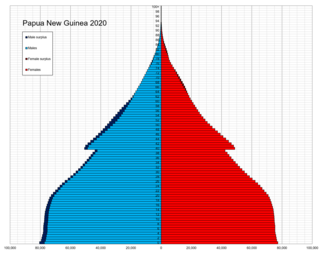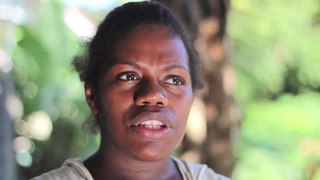
The indigenous population of Papua New Guinea is one of the most heterogeneous in the world. Papua New Guinea has several thousand separate communities, most with only a few hundred people. Divided by language, customs, and tradition, some of these communities have engaged in endemic warfare with their neighbors for centuries. It is the second most populous nation in Oceania, with a total population estimated variously as being between 9.5 and 10.1 million inhabitants.
A pidgin, or pidgin language, is a grammatically simplified means of communication that develops between two or more groups of people that do not have a language in common: typically, its vocabulary and grammar are limited and often drawn from several languages. It is most commonly employed in situations such as trade, or where both groups speak languages different from the language of the country in which they reside.

Tok Pisin, often referred to by English speakers as New Guinea Pidgin or simply Pidgin, is a creole language spoken throughout Papua New Guinea. It is an official language of Papua New Guinea and the most widely used language in the country. However, in parts of the southern provinces of Western, Gulf, Central, Oro, and Milne Bay, the use of Tok Pisin has a shorter history and is less universal, especially among older people.

Bislama is an English-based creole language and one of the official languages of Vanuatu. It is the first language of many of the "Urban ni-Vanuatu" and the second language of much of the rest of the country's residents. The lyrics of "Yumi, Yumi, Yumi", the country's national anthem, are composed in Bislama.

Torres Strait Creole, also known as Torres Strait Pidgin, Brokan/Broken, Cape York Creole, Lockhart Creole, Kriol, Papuan, Broken English, Blaikman, Big Thap, Pizin, and Ailan Tok, is an English-based creole language spoken on several Torres Strait Islands of Queensland, Australia; Northern Cape York; and south-western coastal Papua New Guinea (PNG).

Central Province is a province in Papua New Guinea located on the southern coast of the country. It has a population of 237,016 people and is 29,998 square kilometres (11,582 sq mi) in size. The seat of government of Central Province, which is located within the National Capital District outside the province, is the Port Moresby suburb of Konedobu. On 9 October 2007, the Central Province government announced plans to build a new provincial capital city at Bautama, which lies within Central Province near Port Moresby, although there has been little progress in constructing it.
In linguistics, Melanesian is an obsolete term referring to the Austronesian languages of Melanesia: that is, the Oceanic, Eastern Malayo-Polynesian, or Central–Eastern Malayo-Polynesian languages apart from Polynesian and Micronesian. A typical classification of the Austronesian languages ca. 1970 would divide them into something like the following branches:
Motu is a Central Papuan Tip language that is spoken by the Motuans, an indigenous ethnic group of Papua New Guinea. It is commonly used today in the region, particularly around the capital, Port Moresby.
Unserdeutsch, or Rabaul Creole German, is a German-based creole language that originated in Papua New Guinea as a lingua franca. The substrate language is assumed to be Tok Pisin, while the majority of the lexicon is from German.
Bukawa is an Austronesian language of Papua New Guinea.
Yabem, or Jabêm, is an Austronesian language of Papua New Guinea.

Papua New Guinea, a sovereign state in Oceania, is the most linguistically diverse country in the world. According to Ethnologue, there are 840 living languages spoken in the country. In 2006, Papua New Guinea Prime Minister Sir Michael Somare stated that "Papua New Guinea has 832 living languages ."
Mehek is a Tama language spoken by about 6300 people in a somewhat mountainous area along the southern base of the Torricelli Mountains in northwestern Papua New Guinea. Mehek is spoken in six villages of Sandaun Province: Nuku, Yiminum, Mansuku, Yifkindu, Wilwil, and Kafle. Mehek is most closely related to Pahi, with 51% lexical similarity, and spoken approximately 20 kilometers to the southwest. Mehek is a fairly typical Papuan language, being verb-final, having a relatively simple phonology, and agglutinative morphology. There is very little published information about Mehek. The literacy rate in Tok Pisin, spoken by nearly everyone, is 50-75%. Mehek is not written, so there is no literacy in Mehek. Tok Pisin is primarily used in the schools, with 50% children attending. There is also a sign language used by the large number of deaf people in the Mehek community.

Duna is a Papuan language of Papua New Guinea. It may belong to the Trans New Guinea language family and is often further classified as a Duna-Pogaya language, for Bogaya appears to be Duna's closest relative, as evidenced by the similar development of the personal pronouns. Estimates for number of speakers range from 11,000 (1991) to 25,000 (2002).
Qaqet, or Baining, is a non-Austronesian language from the Baining family spoken in East New Britain Province on the island of New Britain, Papua New Guinea.
Kove is one of the Austronesian languages of New Britain which is spoken by the people of Papua New Guinea. The language is found in 18 villages with their populations totaling 9,000 people; however, most of the people are unfamiliar with the language. Instead of using the Kove language, many of them use Tok Pisin as their daily language.
Mekeo is a language spoken in Papua New Guinea and had 19,000 speakers in 2003. It is an Oceanic language of the Papuan Tip Linkage. The two major villages that the language is spoken in are located in the Central Province of Papua New Guinea. These are named Ongofoina and Inauaisa. The language is also broken up into four dialects: East Mekeo; North West Mekeo; West Mekeo and North Mekeo. The standard dialect is East Mekeo. This main dialect is addressed throughout the article. In addition, there are at least two Mekeo-based pidgins.
Dom is a Trans–New Guinea language of the Eastern Group of the Chimbu family, spoken in the Gumine and Sinasina Districts of Chimbu Province and in some other isolated settlements in the western highlands of Papua New Guinea.
Papuan Pidgin English was a 19th-century English-based pidgin of New Guinea. It was eventually replaced by Hiri Motu, a Melanesian-based pidgin, and was not ancestral to modern English-based Tok Pisin.
Tom Dutton was an Australian linguist specialising in Papuan languages and other languages of Papua New Guinea.






